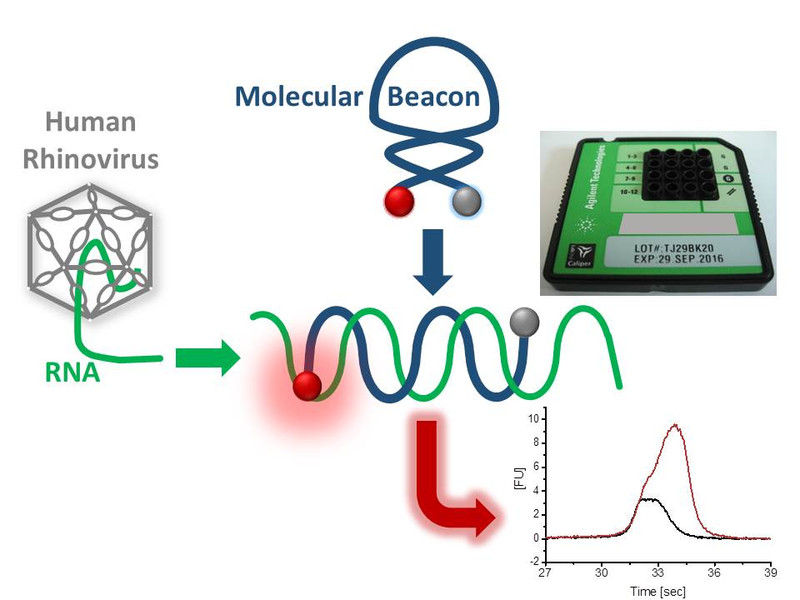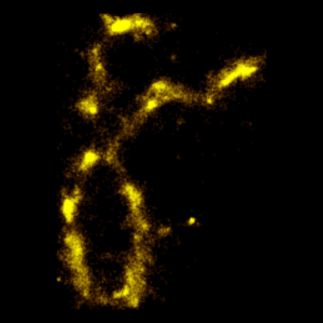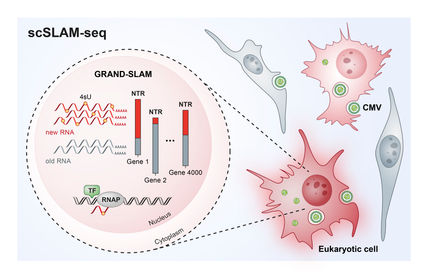How a cold gets into cells
viruses smuggle their genetic material into our cells. How this actually works is currently being investigated at TU Wien (Vienna) using a new combination of analysis methods.

The RNA from the virus is marked with molecular beacons.
TU Wien
Cold viruses cause us irritation by penetrating into our cells and transporting their RNA into the cytoplasma of the infected cells. This is the only way they can multiply. The details of how the transfer of the RNA from within the virus occurs are difficult to study. However, a new method has been developed at TU Wien that can be used to analyse this process. It was developed from the combination of two established procedures – 'molecular beacons' and capillary electrophoresis in chip format.
Mini football with genetic material
The structure of the cold virus, studied by Professor Günter Allmaier and his team from the Institute of Chemical Technologies and Analytics, is relatively simple. It looks like a 'nano football' with a diameter of around 30 nanometers. Its shell consists of four different proteins, with 60 of each of these present. The RNA, which stores the genetic information of the virus, is hidden inside.
"Certain external conditions can also cause the virus to release its RNA to the outside," explains Victor Weiss, postdoctoral scholar of Günter Allmaier. "In our cells this is triggered by a lower pH value; you can also achieve the same effect by increasing the temperature to 57 °C for ten minutes". In this case, the proteins rearrange themselves, the shell of the virus develops holes, and the RNA strand is then released through one of them.
It is important to gain a sound understanding of this mechanism for a number of medical issues – for example, for the future development of drugs that prevent this precise RNA transfer. It has not been possible to directly observe the dynamics of this procedure up to this point. However, in the labs at TU Wien this process has now been made experimentally accessible.
Fluorescent markers and electrophoresis
The process uses molecular beacons; these are customised RNA (or DNA) molecules with two different ends. At one end there is a fluorophore, which flashes if you shine a laser light with a certain wavelength onto it, and at the other is a quencher, which actually prevents this flashing. "To begin with, the molecule is folded up; the fluorophore and quencher are positioned very close to one another, then the fluorescence is very low," explains Victor Weiss.
However, the molecular beacons can latch on to a very specific RNA sequence. If this happens, the molecule unfolds, the fluorophore and quencher are suddenly far apart from one another and if you then shine a suitable laser light on the molecule, it is fluorescent.
It is therefore possible to use these molecular beacons to verify certain RNA sequences. This technique was combined with another proven technique at TU Wien – capillary electrophoresis. This process separates the components of a sample by their electrophoretic mobility (velocity of migration in an electric field). A small liquid sample is placed in a chip channel and an electric field applied there, in which the various nano particles characteristically migrate at different speeds. After a separation distance of around one and a half centimetres, a laser beam then strikes the particle. The flashing fluorophores of the unfolded molecular beacon which could latch onto the virus RNA, are then measured there.
"The different components of the sample reach the laser at different times. This is the only way to be sure that you are actually measuring exactly what you want to measure," explains Mr Allmaier. "We can now demonstrate, for example, from which end of the RNA the virus first emerges, and how this process actually works."
In principle, the method that was developed as part of an FWF project together with the Dieter Blaas research group (Medical University of Vienna) can also be applied to other viruses. "To us it’s about developing the method; as a test object, the cold virus is virtually ideal," says Mr Allmaier. "However, we do of course hope that this method is established in medical research. We have now shown what great potential it has and this is also apparent in the partnership with Agilent Technologies."

























































